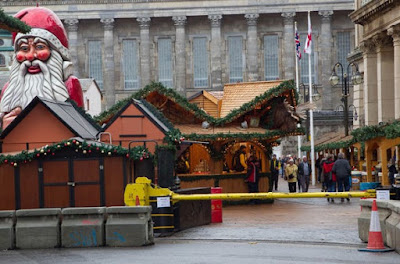Britain has lots of Christmas markets. It also has a recent history of vehicle ramming attacks in public venues. So, how do the British do perimeter anti-ram barriers this holiday season?
My bottom line: they do them with no subtlety at all, and little actual anti-ram effectiveness. The new German fashion of gift-wrapped vehicle barricades has - with one exception - not spread to Britain. But they do present lots of guns, which surprises me. The recent spate of terrorist attacks seems to be making the British more accustomed to and accepting of armed police.
Are there really rings of steel surrounding the markets?
Heavy police presences could be seen in London, Birmingham, Manchester, Leeds, Edinburgh and Bath with armed cops patrolling the perimeters of festive attractions. Plain clothed officers will also mingle amongst the crowds of revellers in a bid to keep the nation safe from further terror attacks. The moves come after the Local Government Association warned councils to be vigilant this year with the terror threat level to the UK currently at "severe".
This means that an attack "is highly likely."
In response to those atrocities barriers separating traffic from pedestrians were erected on three of the capital's bridges. Similar measures are now be in place at major Christmas markets - including Manchester, Birmingham and London's Winter Wonderland in Hyde Park.
I think not. They look more like linked-together small traffic barriers, probably in normal use as mobile highway lane dividers, plus a manually-operated drop bar barrier. While I hate to judge based on just a few photos that don’t show the larger physical context, the configuration of surrounding streets, etc., that is one very weak ring of steel. Or concrete.
The UK police have announced plans for greatly heightened security measures:
Extra measures including armed police patrols, large concrete barriers and stop-and-search checks have been introduced at venues across the country.
Pedestrianised areas are blocked off to prevent vehicles ramming into crowds after ISIS fanatic Anis Amri, a Tunisian failed asylum seeker, killed 12 people and injured more than 50 when he ploughed a lorry through Berlin's Breitscheidplatz last year.
Heavy police presences could be seen in London, Birmingham, Manchester, Leeds, Edinburgh and Bath over the weekend with armed officers patrolling the festive attractions.
Plain clothed officers will also mingle among crowds of revellers as part of the heightened security situation.
I see the checkpoints and bag searches, etc., but I'm still looking for "large concrete barriers." Those small concrete blocks do not have the anti-ram resistance to stop a Berlin-type truck attack, believe me.
And then we come to Bath, where either they ran low on little concrete blocks and had to space them out, or else they expect some very wide trucks.
I mean, you could drive a bus through those openings. Why even bother putting the blocks up?
Only two British markets made an attempt to blend the barricades in with seasonal decorations, the way some German cities did this year. Leeds showed a flare for aesthetic physical security by rejecting concrete and using large soil-filled planters with actual plants in them.
Congratulations, Leeds. But the first place award goes to Hull, which really out-did even the gift-wrapped German barricades we looked at last week.
Well done, indeed. Genuine anti-ram bollards, and they're inside an innocuous disguise. Hull really knows how to hide anti-ram bollards.
In conclusion, Hull's perimeter security has a level of artistic and anti-ram legitimacy that even the Germans would be hard-pressed to match. The rest of the UK's Christmas markets seriously need to up their game.














No comments:
Post a Comment